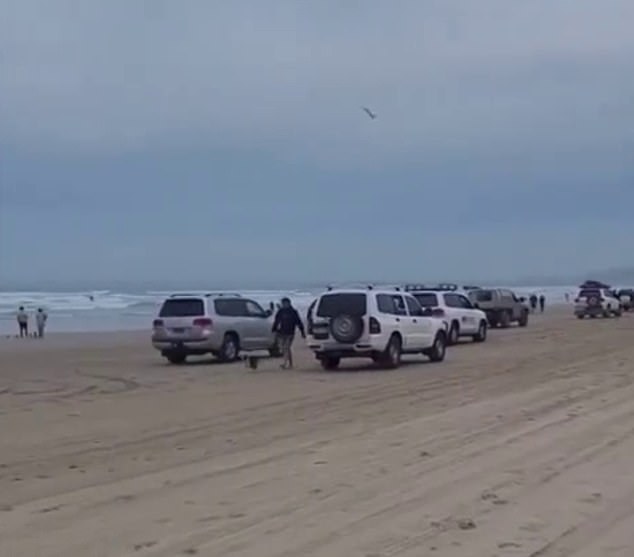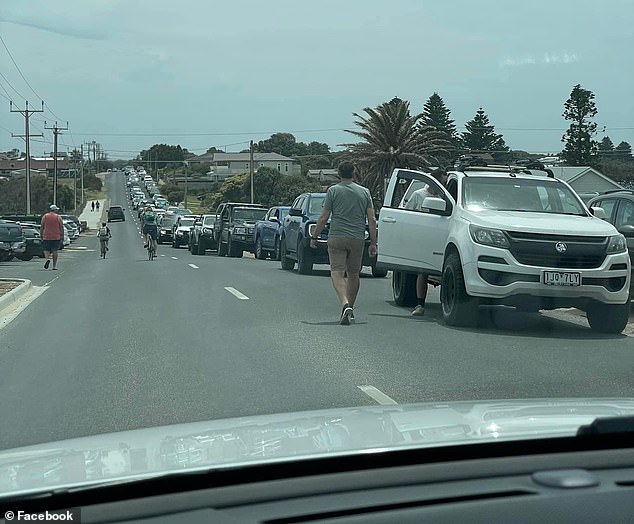Wild footage captures New Year’s Day nightmare at a popular beach in South Australia
Shocking footage has captured 4WD drivers standing in a huge queue as they tried to reach a popular beach for New Year's Day.
Access to Goolwa Beach was closed for hours on Monday when a minor collision occurred in South Australia.
The accident happened on the access road, preventing cars from reaching the beach.
Due to the sheer volume of cars trying to reach the popular spot, heavy machinery was brought in to prevent soft sand from bogging down vehicles, increasing the wait time.
The chaos occurred as drivers and passengers headed onto the beach on the area's first warm day after a wave of cold weather.
Access to Goolwa Beach was closed for hours on Monday when a minor collision occurred on the busy beach in South Australia

The accident happened on the access road, preventing cars from reaching the beach. Vehicles along the sand and the main road were hit
On Facebook, many drivers stuck in traffic said they were frustrated, with some blaming their fellow drivers while others blamed infrastructure.
“I was there… waiting… that loader did nothing but fill the good tracks with soft sand, pretty stupid,” one person wrote.
“Some drivers need to learn how to steer out of a rut before they have a head-on (collision).”
“We were stuck on the beach for over two hours with two small children waiting for it to be cleared and it was chaos,” said another.
Other 4WD enthusiasts accused the council of not doing enough to prepare the busy beach.
“I was at the beginning of that line and I feel that the better prepared work of the municipalities before a busy weekend would certainly reduce the problems and perhaps some traffic control,” one person wrote.
Alexandrina Council Mayor Keith Parkes told Daily Mail Australia not all visitors to the area arrive in suitable vehicles.
“Access from the car park to the beach is via a council controlled path through dunes with very thick soft sand,” he said.
“Unfortunately, some visitors are unprepared or attempt to enter in AWD vehicles rather than 4WDs set up for the conditions.”
Mayor Parkes said the coastal town of 8,000 will multiply by many thousands over the summer period.
“Long queues to enter Goolwa Beach are common at peak times such as New Year's Day and Australia Day, where I have seen more than 700 cars on the beach before COVID restrictions,” he said.
“I believe that Council should look at alternative solutions to manage vehicular access during these peak times, but we should be talking to all stakeholders, including the South Australian Police and the South Australian Government, who are protecting our beaches checks.'

The chaos occurred as tourists hit the beach on the area's first warm day after a wave of cold weather
The influx of tourists to Goolwa Beach came just weeks after a new rule came into effect after damaging 4WD driving at Goolwa Beach on Christmas Day 2022.
Reckless driving left the sand dunes severely damaged and would take years to return to normal.
New speed limit rules for beaches across South Australia were introduced partly as a result of the Goolwa Beach incident, with the default speed now 40km for drivers on the sand.
There is also a 25 km speed limit in effect when traveling within 50 meters of a person.
This is a significant change from the previous speed limit of 100 km on beaches.
The new beach speed limit came into effect on December 1, 2023, with demerit points and fines issued to drivers who ignored the new law.
The South Australian government website explains the changes for beach drivers.
'Beaches provide a unique driving environment that is very different and less predictable than driving on the road. Reducing the speed limit is a feasible way to improve beach safety.”
There were 29 reported accidents on South Australia's beaches over the five years to 2021, resulting in one fatality and 28 injuries.
